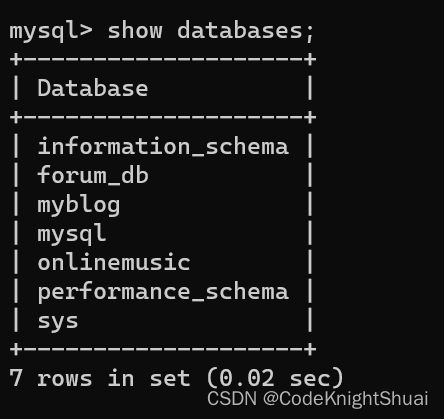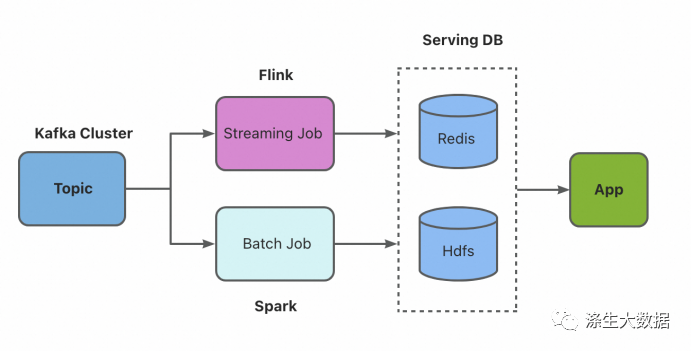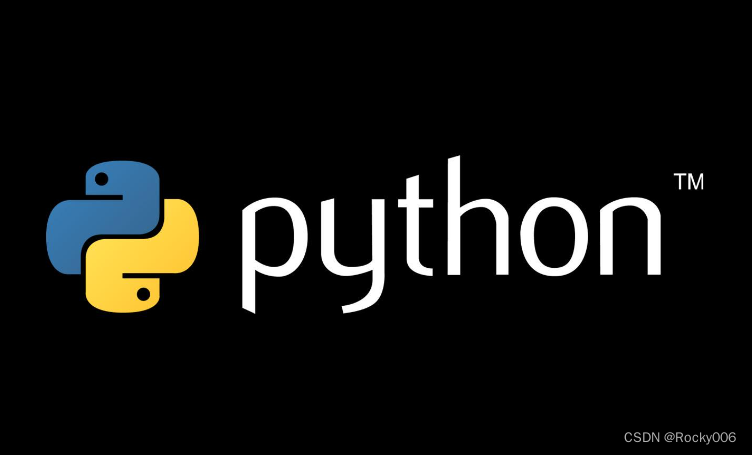前提准备
在使用pymysql的前提就是又一个mysql数据库,这个数据库可以是本地数据库也可以是远程的数据库,
mysql的安装这里就不再赘述了,大家可以参考其他的模块进行安装
pip install pymysql
连接数据库
import pymysql
# 连接数据库
db = pymysql.connect(host='localhost',user='root',password='123456',port=3306)
# 创建数据库的游标
cursor = db.cursor()
#execute()方法并执行 SQL 语句
cursor.execute("select version()")
# 读取第一条数据
data = cursor.fetchone()
print(data)
# 关闭连接
db.close()
# 输出:
# ('8.0.24',)
- host 数据库ip地址,如果是本地可以用localhost或127.0.0.1 如果是远程就需要指定正确的ip地址
- user 用户名
- password 密码
- port 端口号 如果不指定就默认是3306
cursor():获取数据库的操作游标
execute() 执行SQL语句,把要进操作的内容写成SQL语句,
fetchone() 读取一条数据
close() 断开连接,释放资源
“select version()” sql语句的执行结果

创建数据库
import pymysql
# 连接数据库
db = pymysql.connect(host='localhost',user='root',password='123456')
# 创建数据库的游标
cursor = db.cursor()
# 创建数据库spiders
cursor.execute("create database spiders")
# 关闭连接
db.close()

创建数据库命令执行一次就可以,后面我们在创建的数据库中进行其他的操作,如果创建的数据已经存在程序会报错"Can't create database 'spiders'; database exists"
拓展:
如果在创建数据库的不能确认数据库是否存在,但是也不想在创建数据库的时候发生报错可以使用下列语句:
create database if not exists dbname
创建数据表、
表必须创建在数据库内,所以我们需要在连接数据库以后,需要指定操作那个数据库
import pymysql
# 连接数据库
db = pymysql.connect(host='localhost',user='root',password='123456',port=3306,db='spiders')
# 创建数据库的游标
cursor = db.cursor()
sql = "create table if not exists students(id varchar(255) not null,name varchar(255) not null,age int not null,primary key (id))"
cursor.execute(sql)
db.close()

这次的在连接mysql的时候connect函数新增了一个参数,db='spiders'指定我们要连接的数据库,后面创建的表也会创建到当前数据库。
创建数据库的sql语句是 "create table if not exists students(id varchar(255) not null,name varchar(255) not null,age int not null,primary key (id))"
创建的数据库名为students,三列 id、name、age,都是非空,主键为id
插入数据
import pymysql
db = pymysql.connect(user='root',password='123456',host='localhost',port=3306,db='spiders')
cursor = db.cursor()
id = '10005'
name = 'zhangsan'
age = '20'
#方式1
# sql = "insert into students(id,name,age) values('"+id+"','"+name+"','"+age+"')"
# cursor.execute(sql)
# 方式2
# sql = "insert into students(id,name,age) values('{}','{}','{}')".format(id,name,age)
# cursor.execute(sql)
# 方式3(推荐)
sql = "insert into students(id,name,age) values(%s,%s,%s)"
cursor.execute(sql,(id,name,age))
db.commit()
db.close()
通过三种sql语句的编写形式我们能够发现。方式3的最为简洁,通过使用%s来进行占位,然后再通过execute()函数将数据传入sql语句中组成完整的sql语句。
在执行execute()方法之后必须要commit()方法才能将数据插入到表中,这个设计到了事务的原子性问题,事务机制可以确保数据一致性,事务有4个属性:原子性、一致性、隔离性、持久性。
| 属性 | 描述 |
|---|---|
| 原子性 | 事务是一个不可分割的工作单位,事务中包括的操作要么都执行,要么都不执行 |
| 一致性 | 事务必须是数据库中一个一致性状态转变到另一个一致性状态,一致性与原子性是密切相关的 |
| 隔离性 | 一个事务不能被其他事务干扰,即一个事务内部的操作及使用的数据对并发的其他事务时隔离的,并发的各个事务之间不能相互干扰 |
| 持久性 | 持久性也称永久性,指一个事务一旦提交,它对数据库中数据的改变就应该是永久性的,接下来的其他操作或故障不应该对其有任何影响 |
查询数据
import pymysql
db = pymysql.connect(user='root',password='123456',host='localhost',port=3306,db='spiders')
try:
sql = 'select * from students'
cursor = db.cursor()
cursor.execute(sql)
d1 = cursor.fetchone()
print("获取一条数据",d1)
all_d = cursor.fetchall()
print("获取所有数据",all_d)
# sql = "insert into students(id,name,age) values('"+id+"','"+name+"','"+age+"')"
except:
print("Error")
db.close()
数据库中的数据

输出:

通过结果我们能够看到etchone()执行正常,拿出了一条数据,但是fetchall()明明是查询所有,但是结果只有除了第一条之外的数据,关于这个现象我们可以从游标的角度来解释,一开始游标在第一行执行etchone()之后游标就跑到第二行,再执行fetchall()的时候就从第二行开始查询直至末尾。
可以简单的理解etchone()查询游标所在的一行数据,fetchall()查询当前游标至结束的所有行数据。
import pymysql
db = pymysql.connect(user='root',password='123456',host='localhost',port=3306,db='spiders')
try:
sql = 'select * from students where id>10003'
cursor = db.cursor()
cursor.execute(sql)
all_d = cursor.fetchall()
print("获取所有数据",all_d)
# sql = "insert into students(id,name,age) values('"+id+"','"+name+"','"+age+"')"
except:
print("Error")
db.close()
输出:

更新数据
跟新数据,有时候我们再会对数据库中原来的数据进行修改
import pymysql
db = pymysql.connect(user='root',password='123456',host='localhost',port=3306,db='spiders')
try:
sql = 'update students set name=%s where id=%s'
cursor = db.cursor()
cursor.execute(sql,('李四','10004'))
db.commit()
except:
db.rollback()
db.close()
删除数据
import pymysql
db = pymysql.connect(user='root',password='123456',host='localhost',port=3306,db='spiders')
try:
sql = 'delete from students where id<%s'
cursor = db.cursor()
cursor.execute(sql,('10004'))
db.commit()
except:
db.rollback()
db.close()
实战应用
在实际应用时,一般数据都是字典或者对象这种数据,所以需要我们在拼接SQL语句的时候更加的灵活。
import pymysql
data = {
'id':'10006',
'name':'王五',
'age':45
}
# 连接数据库
db = pymysql.connect(user='root',password='123456',host='localhost',port=3306,db='spiders')
table = 'students' # 表名
keys = ','.join(data.keys()) # 拼接插入的字段
values = ','.join(['%s']*len(data)) # 添加占位符
# 使用with关键字,Python 解释器会自动释放资源。 它还提供错误处理
with db:
cursor = db.cursor()
sql = 'insert into {}({}) values({}) on duplicate key update'.format(table, keys, values)
update = ','.join([" {key}=%s".format(key=key) for key in data])
sql += update
try:
cursor.execute(sql, tuple(data.values()) * 2)
db.commit()
except:
db.rollback()
可以发现在sql语句中有 on duplicate key update:当主键存在的时候更新数据。
我们可以根据cursor.execute()的返回值来判断数据是插入操作还是更新操作
总结
通过pymysql我们实现了创建数据库,创建表,以及对数据的增删改查,这种基本的操作,通过这些我们也能够发现pymysql的主要作用就是连接数据库将指令传递给mysql,具体的功能实现还是需要我们自己编写sql语句,因此在使用pymysql的前提是能够熟练编写sql语句。
关于pymysql的一些技巧以及优化后面会有新的文章来讲解

原文地址:https://blog.csdn.net/qq_52007481/article/details/128587650
本文来自互联网用户投稿,该文观点仅代表作者本人,不代表本站立场。本站仅提供信息存储空间服务,不拥有所有权,不承担相关法律责任。
如若转载,请注明出处:http://www.7code.cn/show_25770.html
如若内容造成侵权/违法违规/事实不符,请联系代码007邮箱:suwngjj01@126.com进行投诉反馈,一经查实,立即删除!








